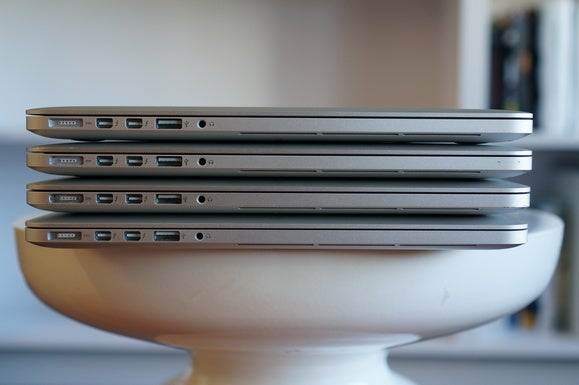Thursday, October 20, 2016
How switching to Macs is paying off for IBM
IBM employees prefer Macs, which is actually saving IBM about $543 per computer.

Staff Writer, Macworld
- Oct 20, 2016 10:34 AM
Last year, IBM made a bold decision. The company let its employees choose between a Windows PC or a Mac for their own work machines. IBM staffers prefer Macs, so the company bought up 30,000 of them. This year, IBM has 90,000 Macs in use. But Macs are expensive, as we all know, so IBM must be spending a fortune on making the switch…right? Apparently not.
IBM said Wednesday at the Jamf Nation User Conference that it’s actually saving money on each Mac: $273 to $543 per Mac over four years, compared to a Windows PC over the same time period. And no, that’s not because Microsoft is charging more. Fletcher Previn, IBM’s vice president of workplace as a service (yeah, that’s a real title), said Microsoft is giving IBM its best pricing ever. But Macs are still cheaper over their lifetime, and using them results in fewer service calls.
This is just one company’s data, but IBM expects to have more than 100,000 Macs in use by the end of this year, so that’s a pretty significant sample size. The company is rolling out 1,300 Macs a week, and only five IT administrators are supporting all of those computers.
This shift is huge for Apple, which has struggled to find footing in enterprise computing. In 2014, the company inked a deal with IBM to develop mobile-first enterprise apps for a variety of industries, a move that has been incredibly successful. The alliance may seem like a strange one to those who remember the early PC era when IBM and Apple were rivals, but IBM doesn’t make Windows PCs anymore and has bolstered Apple’s enterprise presence. Clearly that move is paying off for IBM, too.
Wednesday, October 19, 2016
Reports: Apple has big plans to turn the MacBook keyboard into a display
Imagine an endlessly customizable keyboard that changes its keys based on the app or language you're using.

Staff Writer, Macworld
- Oct 19, 2016 11:35 AM
Apple is reportedly planning to swap out the MacBook Pro’s row of function keys with a touchscreen OLED strip to make the keyboard more contextually relevant. This change heralds a much bigger one: a Kindle-esque e-ink display to replace the QWERTY keyboard.
That means the entire bottom half of the MacBook would be responsive to the app or language you’re using and change according to your needs. This would be incredibly useful for software developers, gamers, and people who communicate in multiple languages—basically anyone who needs special keys, including emoji lovers. According to the Wall Street Journal, the new keyboard is coming in 2018.
The new keyboard will be standard across all MacBooks, the WSJ reports, not a specialized upgrade. The feature is still a ways off, but we’ll get a sense of how it might work if the OLED screen expected to replace the function keys actually comes into being. We could find out as soon as next week—Apple is reportedly unveiling new MacBooks on Oct. 27.
Source
Source
Friday, February 26, 2016
Share Internet Connection with Your Phone
Share Internet Connection with Your Phone
There are three steps involved in creating an AdHoc network: creating your network base, enabling LAN sharing, and connecting your devices to your network.Creating an AdHoc Network
Creating an AdHoc network (WLAN) will allow you to exchange files, share printers, or share internet access.The first step in creating your AdHoc network is to go to your Network and Sharing Center (Start > Network > Network and Sharing Center). Click on the Manage Wireless Networks button located in the left bar. Then click on Add.
In the window that opens, select Create Network AdHoc, followed by Next. Choose a Network Name. This will be the SSID of the network you are connecting to your device.
In the Security Type select No authentication (Open). Finally, select Save this network, and click on Next.
Let the utility work. If it asks you to share your connection, you should accept the request and proceed directly to Step 3. Otherwise, proceed to Step 2.
LAN Sharing
Now, we are going to instruct Windows to allow LAN sharing. This will allow your computer to access the connection from your device.
Go back to the Network and Sharing Center(Start> Network> Network and Sharing Center). On the left-hand side, click on Change Settings Map.
Right-click on Local Area Connection and select Properties. Then, go to the Sharingtab.
Check Allow other network users to connect through this computer's Internet connection, followed by OK.
Head to the Network and Sharing Centerone last time, and click on Connect or Disconnect.
In the window that opens, click on the network name you created, and click Connect.
Go into the application settings of your iPhone, iPod, or iPad and tap on WiFi. Make sure that your WiFi is enabled, and tap on the network name that you chose in step 1.
Once connected, test your internet connection by simply opening an internet browser application.
Go back to the Network and Sharing Center(Start> Network> Network and Sharing Center). On the left-hand side, click on Change Settings Map.
Right-click on Local Area Connection and select Properties. Then, go to the Sharingtab.
Check Allow other network users to connect through this computer's Internet connection, followed by OK.
Connecting to an AdHoc Network
It is now time to ask the PC to connect to the AdHoc network.Head to the Network and Sharing Centerone last time, and click on Connect or Disconnect.
In the window that opens, click on the network name you created, and click Connect.
Go into the application settings of your iPhone, iPod, or iPad and tap on WiFi. Make sure that your WiFi is enabled, and tap on the network name that you chose in step 1.
Once connected, test your internet connection by simply opening an internet browser application.
Source-http://ccm.net/faq/11659-transfer-pc-internet-connection-to-iphone?
Subscribe to:
Comments (Atom)
